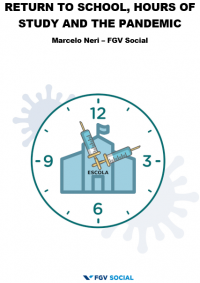
Return to School, Hours of Study and the Pandemic
About the research:
Our starting point is to gauge movements of exits and returns to school during the pandemic. We document a rise in school dropout rates for the 5 to 9 years old bracket from 1,41% to 5,51% between the last quarters of 2019 and 2020. The peak of the pandemic’s level correponds to the value observed 14 years earlier. In the third quarter of 2021, the dropout rate falls to 4,25%, still 128% higher than the same quarter of 2019, just before the pandemic’s start. We also find heterogeneity in dropout rates changes across age groups. The youngest left schools more often and returned less often to school activities. Consistent with that, children had higher rates of stricter social distancing measures in September 2020 (39,1% from 5 to 9 years old, above the 23,9% of those with 60 years or plus, or the 10,1% for the group of 15- to 19-year-olds). There is a school exit cycle during the academic year that should be dealt with in its beginning, because it sets a floor for dropouts during the whole year.
As a complement, we propose a simple indicator which works as a clock, indicating the hours dedicated by each potential student to in-person or distanced learning. This indicator considers the issue of being enrolled or not, in addition to counting the days and hours actually spent with remote education. To estimate this indicator we used the educational data collected by the PNAD COVID/IBGE. The indicator of time for studies recorded for the group aged 6 to 15 years old in September 2020 was 2 hours and 22 minutes per working day, 40.9% lower than the minimum estabilished by federal law of 4 hours/day (Basic Education Guidelines Act), and below international standards. The poorest students, those enrolled in public schools, who live in more remote areas, and especially the youngest students, were the ones who lost relatively more time of study during the pandemic. School enrollment loss during such period represents a return to 2006 levels, and broader study-time measures point out an even larger decrease, especially for low-income individuals. For instance, the study time loss for Bolsa Família students was of 50% between 2006 and 2020.
The lack of school activities perceived by students is more related to the inexistence of educational activities offered by the government and teachers than to the students' own demand for them. While 12% of students aged 6 to 15 did not receive distance learning materials, only 2.7% did not use them for any other reason. Most students did not perform school tasks due to supply problems (as they did not receive school tasks from the government or schools), which aflicted 38.9% of the students in Pará, compared to 2.09% in Paraná. In short, the results suggest an increase in regional inequalities in Brazil during the pandemic, in addition to a loss in human capital accumulation and equality, which may signify negative effects for the country in the long run. Children’s vaccination against Covid-19 could present itself as crucial condition to school return with safety for all.
I Text (In portuguese)
I Appendix (In portuguese)
l Slides - Visualization / Print (In portuguese)
I Map (Brazil) Time for Studies (hours per week day) - 6 to 15 years: Units of the Federation / Capitals
I Videos (In Portuguese): Presentation (4 minutes) / Teaser (1 minute)
| Contact: fgvsocial@fgv.br / +5521 3799-2320




